The Big Dipper asterism is made up of the seven brightest stars of Ursa Major — Alkaid, Mizar, Alioth, Megrez, Phecda, Dubhe and Merak, with Alioth being the brightest star in the constellation Ursa Major and the 32nd brightest star in the sky. Alkaid, Mizar and Alioth mark the Big Dipper’s handle or the Great Bear’s tail, while Megrez, Phecda, Dubhe and Merak outline the Dipper’s bowl or the Bear’s hindquarters.
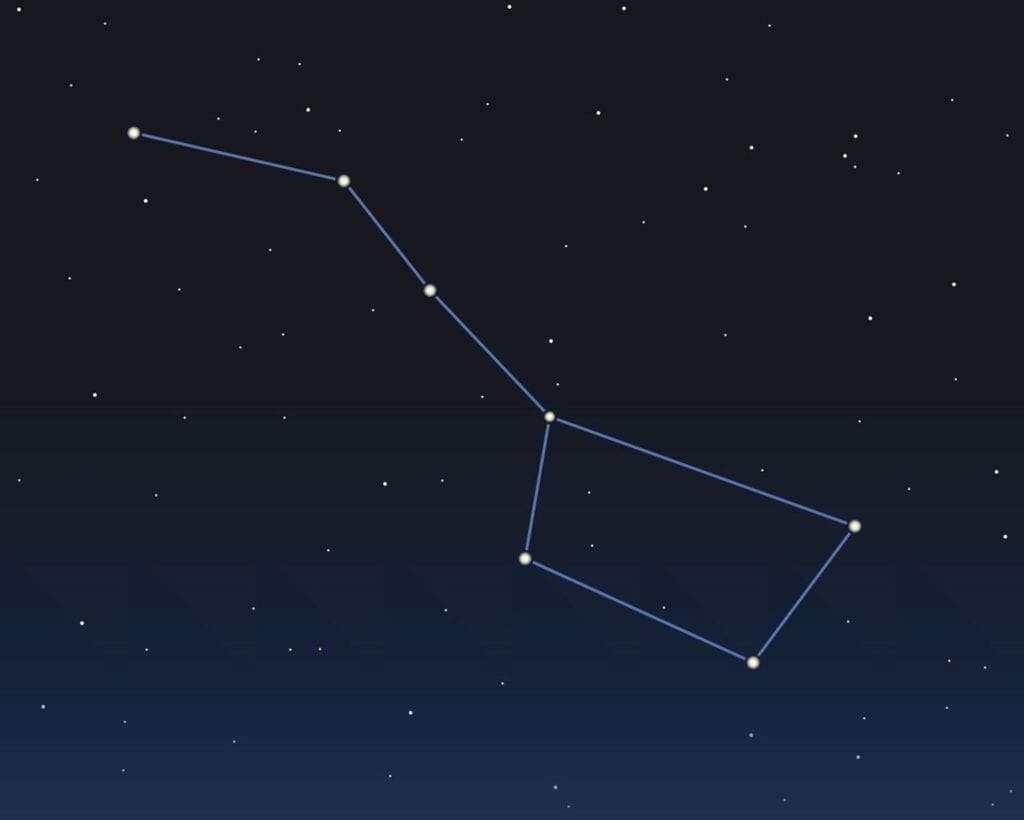
Ursa Major is the third largest of all 88 constellations, and often The Big Dipper is confused for the constellation itself. The Big Dipper itself is not a constellation, but only the most visible part of Ursa Major.
The Big Dipper is most prominent in the northern sky in summer and is one of the first star patterns learned in astronomy. There are many deep sky objects in the the same region of the sky as the Big Dipper, such as the Whirlpool Galaxy, the Pinwheel Galaxy, the double star Winnecke 4, Bode’s Galaxy and the irregular Cigar Galaxy.
History and Mythology of The Big Dipper Asterism
The Big Dipper is associated with many different myths and folk tales in cultures across the world.
In Hindu astronomy, the Big Dipper is known as Sapta Rashi – The Seven Great Sages. In an Arabian story, the stars that form the bowl of the Big Dipper represent a coffin, and the three stars marking the handle are mourners following it. In China, the seven stars are known as the Government, or Tseih Sing, while in Malaysia, the asterism is called Buruj Biduk or The Ladle. In Mongolia, it is known as the Seven Gods.
In Scandinavian mythology, the stars of the Big Dipper were known as Odin’s Wain or Odin’s Wagon. An old English name for the asterism is Charles’ Wain (wagon), which is derived from the Scandinavian Karlavagnen, Karlsvognen, or Karlsvogna.
The Romans knew the seven stars as the “seven plough oxen,” or Septentrio, with only two of the seven stars representing oxen and the others forming a wagon pulled by the oxen.
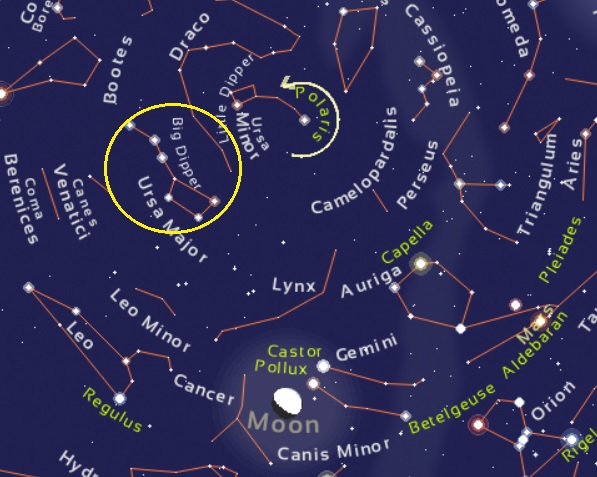
Location of The Big Dipper Asterism
The Big Dipper is located in the constellation Ursa Major, which spreads out for over 1,280 square degrees. Ursa Major lies in the second quadrant of the northern hemisphere (NQ2) and is visible at latitudes between +90° and -30°. Its right ascension is 10.67 hours and its declination is +55.38 degrees. It is best seen at 9pm during the month of April.
The neighboring constellations to Ursa Major are Bootes, Camelopardalis, Canes Venatici, Coma Berenices, Draco, Leo, Leo Minor, and Lynx. The constellation of Ursa Major belongs to the Ursa Major family of constellations, along with Bootes, Camelopardalis, Canes Venatici, Coma Berenices, Corona Borealis, Draco, Leo Minor, Lynx, and Ursa Minor.
The bright stars of the Big Dipper asterism mark the celestial bear’s tail and hindquarters. The stars that mark the celestial bear’s head, torso, legs and feet are not as bright or as easy to see as the seven stars of the Big Dipper.
The Big Dipper is circumpolar in most of the northern hemisphere, which means that it does not sink below the horizon at night. The appearance of the Big Dipper changes from season to season. In autumn, it rests on the horizon in the evening. In winter evenings, the handle appears to be dangling from the bowl. In spring, it is upside down in the evening hours, and in summer the bowl leans toward the ground.
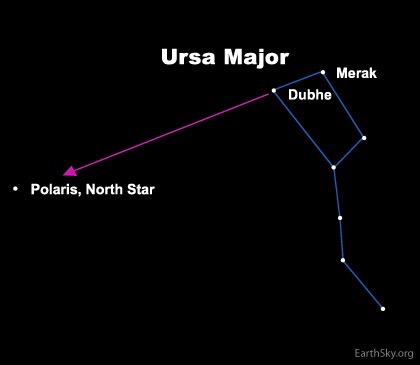
Stars
Seven stars from the Ursa Major constellation make up the Big Dipper asterism. The star names in Big Dipper mostly refer to the stars’ positions in Ursa Major. Five of the seven Dipper stars belong to the Ursa Major Moving Group, also known as Collinder 285. The Ursa Major Moving Group is a group of stars that share a common origin, proper motion and common velocities in space.
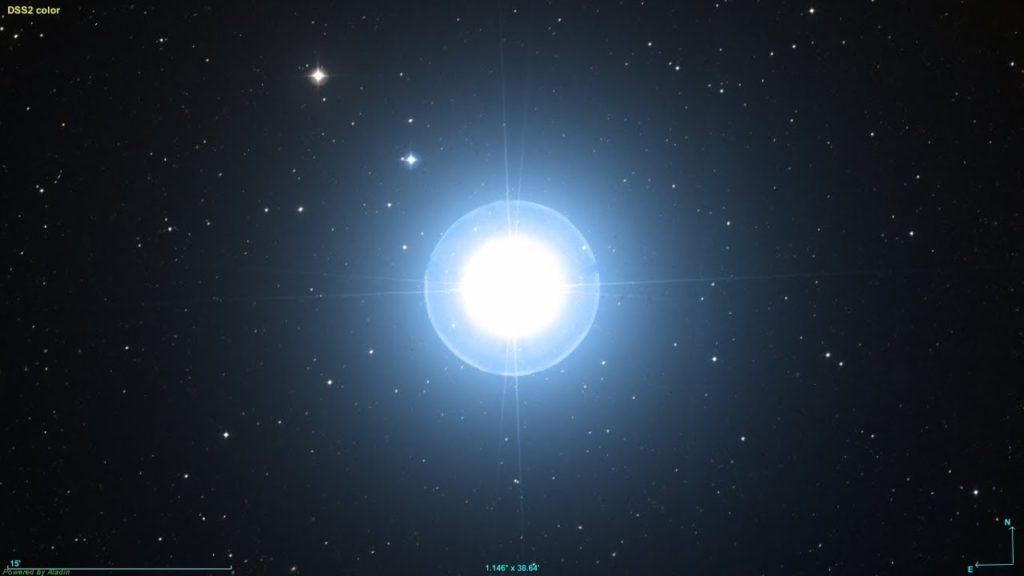
Alioth
Alioth, also known as Epsilon Ursae Majoris, is the brightest star in the Big Dipper asterism and the brightest star in Ursa Major. It is the third star of the asterism’s handle, closest to the bowl. Its name comes from the Arabic alyat, meaning “fat tail of a sheep”.
It is a white star that is coming to the end of its main sequence lifetime, with the stellar classification of A1III-IVp kB9. It has a visual magnitude of 1.77 and is about 82.6 light years away from us.
Alioth is 4.14 times larger than the Sun and is 102 times brighter than the Sun. It also has a mass than is 2.91 times that of the Sun. It is estimated to be 300 million years and has a temperature of 9,020 K.
It is classified as a Canum Venaticorum variable star, meaning it varies in brightness due to its magnetic field and its chemical peculiarity. Its magnetic field is 100 times greater than Earth’s.
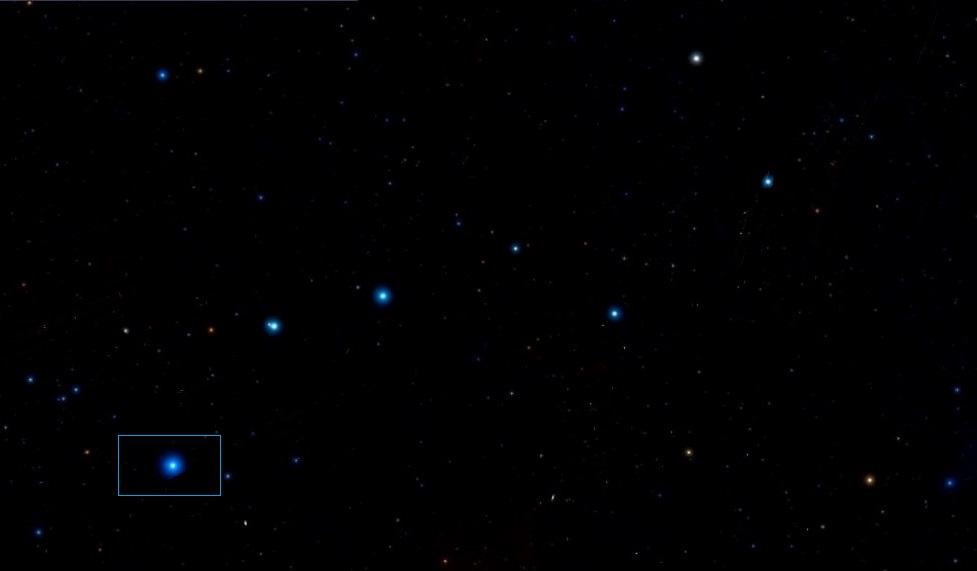
Alkaid
Alkaid, also known as Benetnash or Eta Ursae Majoris, is one of the hottest stars visible to the naked eye and the third brightest star in Ursa Major. It is also the 38th brightest star in the night sky. It is a blue main-sequence star of the spectral type B3V. It has an apparent magnitude of 1.86 and is about 103.9 light years away from Earth.
The name Alkaid comes from the Arabic qā’id bināt na’sh, meaning “the leader of the daughters of the bier”, and it is the star marking the tip of the handle of the Big Dipper, or the tip of the Great Bear’s tail.
Alkaid is 3.4 times larger than the Sun and 6.1 times more massive than the Sun. It has a surface temperature of 15,540 K and is 594 times more luminous than the Sun.
It was once one of the 15 Behenian Fixed Stars – a group of stars used in medieval times in magic rituals.
Mizar
Mizar, also known as Zeta Ursae Majoris, is a quadruple star system that consists of two spectroscopic binary stars. It was the first double star to be photographed, in 1857. Its name comes from the Arabic mīzar, meaning “girdle”. It is the middle star in the Big Dipper’s handle and it forms a naked-eye double with Alcor, a fainter binary star located at a separation of about 12 arcminutes.
Mizar has an apparent magnitude of 2.23 and is 82.9 light years away from us. It is the fourth brightest star in Ursa Major. The primary star is a blue-white hydrogen fusing dwarf, which has around 2.2 times our Sun’s mass and 2.4 times its radius. It is also 33.3 times brighter than our Sun.
Megrez
Megrez, also known as Delta Ursae Majoris, is the dimmest of the seven stars in the Big Dipper asterism and has an apparent magnitude of 3.312. Its name comes from the Arabic al-maghriz, meaning “the base,” referring to the base of the Big Bear’s tail.
Megrez is a white main sequence star of the spectral type A3 V that is located 80.5 light years away. It has a mass of 1.63 times that of the Sun and a radius of 1.4 times that of the Sun. It is also 14 times more luminous than the Sun and has a surface temperature of about 9,480 K.
It is thought to be around 300 million years old. It also has a rotational velocity of around 233 km/144.7 mi per second.
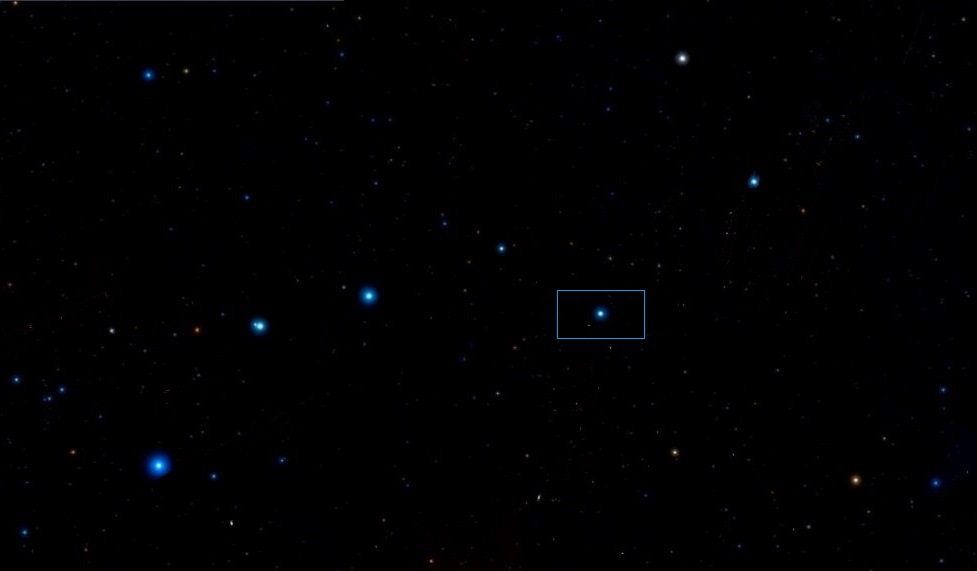
Phecda
Phecda, also known as Phad or Gamma Ursae Majoris is a white main sequence dwarf of the stellar classification A0Ve. Its name comes from the Arabic fakhð ad-dubb, meaning “the thigh of the bear”.
Phecda has an apparent magnitude of 2.438 and lies around 83.2 light years away from us. It has a mass that is 2.94 times that of the Sun and a radius that is 3.04 times. It has a temperature of 9,355 K and is 65.255 times more luminous than the Sun.
Phecda is one of the stars forming the Big Dipper’s bowl and the Great Bear’s hindquarters. It is the lower-left or southernmost star of the Big Dipper’s bowl. It has an astrometric binary companion — an orange dwarf of the spectral type K2 V. It perturbs it and causes it to wobble around the centre of mass. The two stars have an orbital period of 20.5 years.
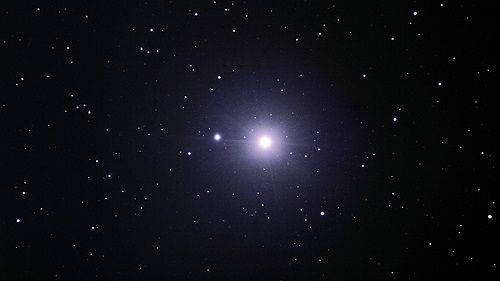
Dubhe
Dubhe, also known as Alpha Ursae Majoris, is the second brightest star in Ursa Major and a spectroscopic binary star system. Its name comes from the Arabic dubb, meaning “bear,” abbreviated from the phrase żahr ad-dubb al-akbar, meaning “the back of the Greater Bear”.
Dubhe has a visual magnitude of 1.79 and is located about 123 light years away from Earth. It is a an orange giant with the stellar classification of K0III, while the companion is a white main sequence of the spectral type F0V.
It is 316 times more luminous than the Sun and is 4.25 times more massive. It is a slow spinner, with a projected rotational velocity of 2.6 km/s. The companion only has around 1.6 solar masses and a visual magnitude of 4.86.
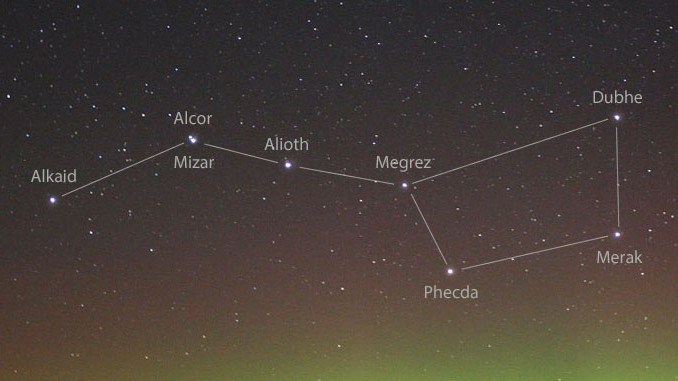
Merak
Merak, also known as Beta Ursae Majoris, is the fifth brightest star in Ursa Major. It is a bluish-white subgiant star of the spectral type A1IVps, that has exhausted its hydrogen supplies, and thus it has begun to cool down.
Its name comes from the Arabic al-maraqq, meaning “the loins”, and it has an apparent magnitude of 2.37. It is located around 79.7 light years away from us. Merak is one of the four stars which form the bowl of the Big Dipper.
It has a mass that is 2.7 times that of the Sun and a radius 3.021 times that of the Sun. It is also 63.015 times more luminous than the Sun, with a surface temperature of 9,377 K. It is thought to be around 500 million years old.
Guide To Other Stars
The Big Dipper asterism can be used to help find other bright stars in the night sky. The arc of the Big Dipper’s handle leads to Arcturus, which is the brightest star in the constellation of Bootes.
The Big Dipper can also be used to find Spica, which is the brightest star in the constellation of Virgo and the 17th brightest star in the night sky.
Megrez and Phecda point the way to Regulus, which is the brightest star in the constellation of Leo, and Alphard, which is the brightest star in the constellation of Hydra.
Following an imaginary line beyond the star Dubhe, two of the stars marking the cup of the Big Dipper show the way to Polaris, the current North Star, which then reveals the Little Dipper asterism. The Little Dipper is formed by the seven brightest stars in Ursa Minor constellation and lies near to the Big Dipper, yet its stars are not as bright.
The Future
The Big Dipper asterism will continue to be visible in the future. However, the stars will be at different locations in around 50,000 years or so. This will result in the asterism changing its shape and facing the opposite side.
That being said, because most of the stars that form the asterism, except Alkaid and Dubhe, are members of the Ursa Major Moving Group, which means that they share common motion through space, the asterism will not look significantly different.
Extra Facts
- In Slavic languages and in Romania, the Big and Little Dipper are known as the Great and Small Wagon.
- In Germany, the Big Dipper is known as Großer Wagen, or the Great Cart.
- In the UK and Ireland, the Big Dipper is known as the Plough, and sometimes as the Butcher’s Cleaver in northern parts of England.
- Some Native Americans saw the bowl as a bear and the three stars of the handle either as three cubs or three hunters following the bear.
- In Africa, the seven stars were sometimes seen as a drinking gourd. This is believed to be the origin of the name the Big Dipper, most commonly used for the figuration in the U.S. and Canada.
Images:
Some Images created with the NightVision app – https://www.nvastro.com/nvj.html
Some Images created with the Stelvision Sky Map https://www.stelvision.com/en/sky-map/
The Big Dipper 1 – https://www.pinterest.co.uk/pin/598626975455711633/
The Big Dipper 2 – https://earthsky.org/tonight/big-dipper-points-to-polaris-aids-in-finding-thuban-2
Alioth – https://nineplanets.org/alioth-ε-ursae-majoris/
Alkaid – https://www.star-facts.com/alkaid/
Phecda – https://www.star-facts.com/phecda/
Dubhe – https://nineplanets.org/dubhe-α-ursae-majoris/
Merak – http://www.astronomytrek.com/star-facts-merak/